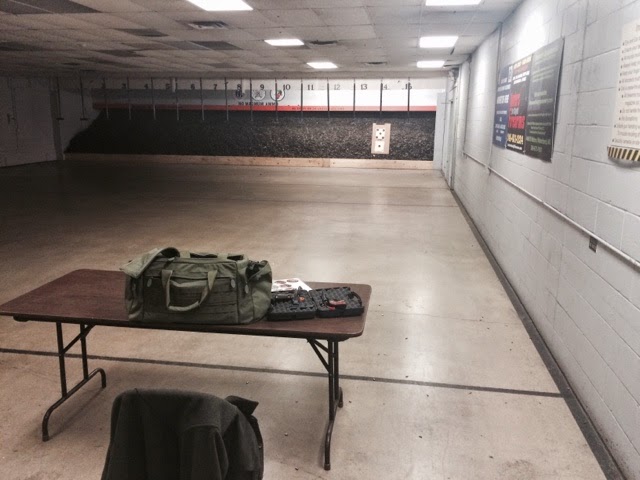While most of my collection consists of revolvers, I have long been a fan of the old High Standard pistols, which combined solid steel construction with great reliability and accuracy. While I'd like to find one of their high end competition pistols at an affordable price, I'm no less a fan of their lower end pistols- like this Duramatic M101 that caught my eye at the local Cabelas. This is one of the cheapest High Standard .22s, but it's just as solid and well made as the better guns, and it came with the original box and all the original paperwork. I managed to negotiate the price down $50 from the asking price (it had been there for a while) and it followed me home.
This pistol is very well designed, with a lot of attention given to service and maintenance. The safety is a simple cross bolt, located in the rear of the receiver, that performs several functions.
See those two notches in the slide? The rearmost one is engaged by the cross bolt when the slide is forward, locking the slide in place. The forward notch is used for locking the slide open, as you see in the photo above.
Once the slide is locked open, turning the large wheel in front of the trigger guard loosens the screw holding the barrel in place. This is very different from just about every other HS pistol, which all used a push-button barrel release, like the S&W 41 and 23A.
One the barrel is removed, the slide can be removed by simply sliding it forward:
Note that the striker/firing pin is in the fully cocked position, held in place by the sear; locking the slide back also cocked the striker. Don't touch the trigger while the gun is disassembled unless you want to see the striker shoot forward with a lot of force! (I accidentally did that the next time I had the gun disassembled for cleaning. Now I put the safety back on after moving the slide.) The rear end of the striker is painted red, and protrudes slightly out the back of the receiver when cocked, giving a nice visual indication.
Once the slide and barrel are off you can loosen the trigger guard retaining screw (just a few turns are needed) and the screw that holds the grip in place and remove the grip. At that point you'll notice that there's no metal grip that's part of the frame; the plastic grip is both the band grip, and the support for the magazine! I like to remove it when cleaning the gun as I'm concerned that some of the solvents used in cleaning might attack the plastic. (If you do manage to damage the plastic grip, all is not lost; modern replacements are being made from the original mods and can be had for $50 or so.)
I brought the carefully cleaned, lubed, and reassembled gun to my club this morning, early enough that I had the indoor 50 foot range to myself for several hours, so I was able to do testing at distances from a few yards to the full 50 feet. I used several different standard velocity .22LR cartridges, including CCI Standard Velocity, Federal Match, Federal Auto Match, Aguila Pistol Match, Wolf Match, SK Match, and Aguila SSS 60gr. The gun functioned flawlessly with everything for the first hundred or so rounds, but as it got dirtier some of the rounds didn't feed as well, and the bullets hung up on the feed ramp.
Accuracy was hard to judge, as the gun shot several inches high at 50' with the ammunition I was using. The rear sight is a battered-looking thing with no adjustment, so I was stuck with that for the moment. It did seem to group reasonably well; I plan on going back with more targets and a brass hammer and punch so I can move the rear sight. I might even find a small adjustable sight I can install.
Postscript: Six months after buying this pistol I sold it. I was tempted to keep it, as it's a beautiful example of the kind of design and solid construction you simply don't see in modern pistols, but I only have so much room. I also have a really nice High Standard Supermatic Citation now that's the most accurate and the best shooting pistol I've ever owned.
There is one modern pistol that's built the way they used to be built, and that's because it's the grandfather of all modern auto pistols: The 1911. The best ones still have that solid feel and give the impression that they were milled from a block of steel- because they were. I've never owned a 1911, but I've always wanted either a standard Government model or a serious wadcutter target model.







No comments:
Post a Comment